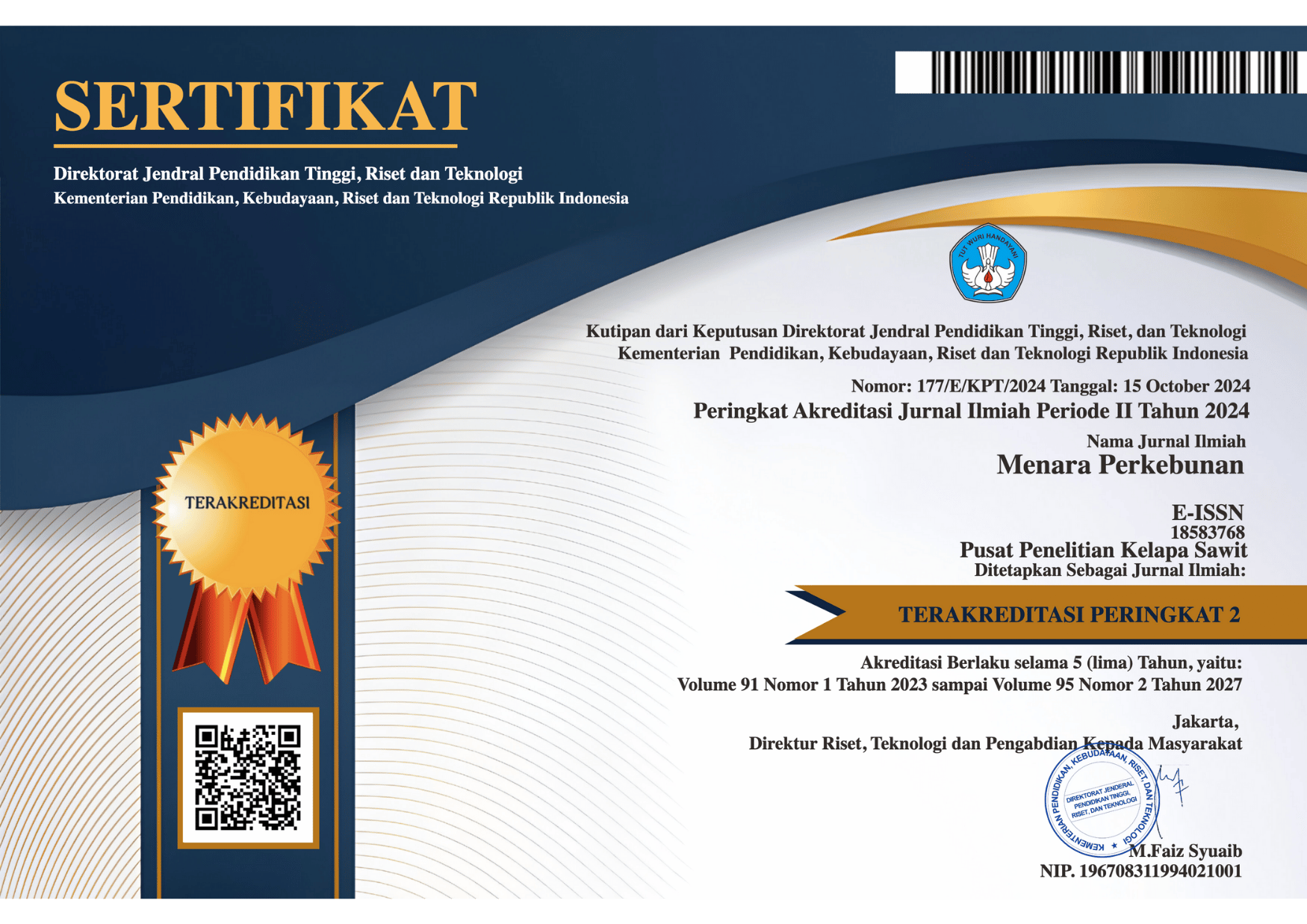Kemiripan genetik klon karet (Hevea brasiliensis Muell. Arg.) berdasarkan metode Amplified Fragment Length Polymorphisms (AFLP) Genetic similarity of rubber clones (Hevea brasiliensis Muell. Arg) based on Amplified Fragment Length Polymorphisms (AFLP) method
DOI:
https://doi.org/10.22302/iribb.jur.mp.v71i1.180Keywords:
Hevea brasiliensis, AFLP markers, polymorphism, clone resistance, Corynespora cassiicolaAbstract
Summary
Genetic similarity among ten rubber clones originating from the Wickham collection was studied by Amplified Fragment Length Polymorphism (AFLP) markers. These clones have different levels of resistance to Corynespora cassiicola, one of the major pathogens in rubber plantations. The information resulted from this study will be used to determine resistant and susceptible clones which will be used in expression study of the genes encoding plant resistance to C. cassiicola. Genetic similarity values of clones were calculated from all AFLP markers and used to produce a dendrogram using Unweight Pair-Group Method Arithmetic (UPGMA) based on Numerical Taxonomy and Multivariate System (NTSYS) version 1.8 pc. A total of 481 fragments were detected by using ten pairs of selective AFLP primers, and 233 fragments (48,4 %) of them were polymorphic. The results clearly demonstrated that genetic background of these ten clones were 85.5% similar. At 88.0% similarity level, the clones could be divided into three clusters. Genetic similarity of IRR 100 (resistant clone) with RRIC 103, PPN 2444 and IAN 873 (susceptible clones) was 90.5, 89.5 and 89.0% respectively, while genetic similarity of other three resistant clones (AVROS 2037, PR 255 and BPM 1) to those susceptible clones was 88.0%. The lowest genetic similarity (85.5%) was found between RRIC 100 (resistant clone) and those three susceptible clones. By considering the distribution and the source of clones, AVROS 2037 (resistant) and PPN 2444 (susceptible) clones which have 88.0% genetic similarity will finally be selected for the expression study of the genes.
Kemiripan genetik sepuluh klon karet yang berasal dari koleksi Wickham dipelajari dengan menggunakan marka Amplified Fragment Length Polymorphism (AFLP). Kesepuluh klon tersebut memiliki tingkat resistensi berbeda terhadap Corynespora cassiicola, salah satu cendawan patogen penting pada daun tanaman karet. Informasi yang diperoleh dalam penelitian ini akan digunakan untuk menetapkan klon resisten dan klon rentan untuk digunakan dalam mempelajari ekspresi gen yang menyandikan ketahanan tanaman karet terhadap C. cassiicola. Nilai kemiripan genetik kesepuluh klon karet dihitung berdasarkan semua marka AFLP yang diperoleh dan selanjutnya digunakan untuk. membuat dendrogram dengan menggunakan Unweight Pair-Group Method Arithmetic (UPGMA) berdasarkan Numerical Taxonomy and Multivariate System (NTSYS) version 1.8 pc. Dengan menggunakan 10 pasang primer AFLP selektif diperoleh sebanyak 481 fragmen DNA, S 2037, PR 255 and BPM 1) to those susceptible clones was 88.0%. The lowest genetic similarity (85.5%) was found between RRIC 100 (resistant clone) and those three susceptible clones. By considering the distribution and the source of clones, AVROS 2037 (resistant) and PPN 2444 (susceptible) clones which have 88.0% genetic similarity will finally be selected for the expression study of the genes. 233 fragmen (48,4 %) di antaranya polimorfik Dendrogram dengan nyata menunjukkan bahwa 85,5% latar belakang genetik kesepuluh klon karet tersebut adalah sama, dan pada tingkat 88,0% kesepuluh klon terpisah dalam tiga kelompok. Kemiripan genetik klon IRR 100 (resisten) dengan klon rentan RRIC 103, PPN 2444 dan IAN 873 masing-masing adalah 90,5, 89,5 dan 89,0%, sedangkan kemiripan genetik tiga klon resisten lainnya (AVROS 2037, PR 255 dan BPM 1) dengan ketiga klon rentan yang sama adalah 88,0%. Kemiripan genetik terendah (85,5%) terdapat antara klon RRIC 100 (resisten) dengan ketiga klon rentan tersebut. Dengan mempertimbangkan distribusi penyebaran klon dan asal klon maka klon resisten AVROS 2037 dan klon rentan PPN 2444 yang memiliki kemiripan genetik 88,0% akan dipilih untuk digunakan dalam studi ekspresi gen tanaman karet. acerun:yes'> Kesepuluh klon tersebut memiliki tingkat resistensi berbeda terhadap Corynespora cassiicola, salah satu cendawan patogen penting pada daun tanaman karet. Informasi yang diperoleh dalam penelitian ini akan digunakan untuk menetapkan klon resisten dan klon rentan untuk digunakan dalam mempelajari ekspresi gen yang menyandikan ketahanan tanaman karet terhadap C. cassiicola. Nilai kemiripan genetik kesepuluh klon karet dihitung berdasarkan semua marka AFLP yang diperoleh dan selanjutnya digunakan untuk. membuat dendrogram dengan menggunakan Unweight Pair-Group Method Arithmetic (UPGMA) berdasarkan Numerical Taxonomy and Multivariate System(NTSYS) version 1.8 pc. Dengan menggunakan 10 pasang primer AFLP selektif diperoleh sebanyak 481 fragmen DNA, S 2037, PR 255 and BPM 1) to those susceptible clones was 88.0%. The lowest genetic similarity (85.5%) was found between RRIC 100 (resistant clone) and those three susceptible clones. By considering the distribution and the source of clones, AVROS 2037 (resistant) and PPN 2444 (susceptible) clones which have 88.0% genetic similarity will finally be selected for the expression study of the genes.
Downloads
Downloads
Submitted
Published
How to Cite
Issue
Section
License
Authors retain copyright and grant the journal right of first publication with the work simultaneously licensed under a Creative Commons Attribution License that allows others to share the work with an acknowledgement of the work's authorship and initial publication in this journal.













